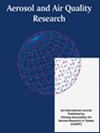Spatiotemporal Variations in Chemical Composition of Wet Atmospheric Deposition in Mexico City
IF 2.5
4区 环境科学与生态学
Q3 ENVIRONMENTAL SCIENCES
引用次数: 0
Abstract
A comprehensive analysis of the chemical composition of wet atmospheric deposition was performed on 7048 samples collected between 2003 and 2021 over Mexico City. The descending ion abundance trend was NH 4+ > SO 42– > NO 3– > Ca 2+ > Cl – > H + > Mg 2+ > Na + > K + , probably associated with industrial activity, heavy traffic and agricultural activities. Although main precursors have decreased importantly, ion composition did not show a clear trend throughout the years. Maximum concentrations of major ions were found in the northern and central part of the megacity, due to the impact of the Tula industrial corridor located north of the city. Weekly pH values varied from 3.6 to 9.4, being 27.1% of the values acidic. Fractional acidity showed that in sites located at higher altitudes, maximum 84.5% of the acidity was neutralized, whereas at northern stations at lower altitudes neutralization was observed up to 98%, due to the presence of alkaline species coming from the cement industry. Average ratios of (NH 4+ + Ca 2+ )/(NO 3– + SO 42– ) were > 1, suggesting neutralization of SO 42– and NO 3– by NH 4+ and Ca 2+ . Average NO 3– /SO 42– ratios suggested that the acidity was mainly influenced by sulfates coming from H 2 SO 4 . Wet deposition ranged from 4–9.9 kg ha –1 year –1 and from 8.2– 17.6 kg ha –1 year –1 for sulfur and nitrogen, respectively, among the geographical areas. The results of this study highlight the sensitivity of wet deposition chemistry to geographical, elevation and source considerations.墨西哥城湿大气沉积化学成分的时空变化
对2003年至2021年在墨西哥城收集的7048个样品进行了湿大气沉积化学成分的综合分析。离子丰度下降趋势为nh4 + > so42 - > no3 - > ca2 + > Cl - > H + > Mg 2+ > Na + > K +,可能与工业活动、交通繁忙和农业活动有关。虽然主要前体有明显的减少,但离子组成在历年没有明显的变化趋势。由于位于城市北部的图拉工业走廊的影响,大城市的北部和中部地区发现了主要离子的最大浓度。每周pH值在3.6 ~ 9.4之间变化,27.1%为酸性。分数酸度表明,在高海拔地区,最高84.5%的酸度被中和,而在低海拔地区的北部站点,由于水泥工业中碱性物质的存在,中和率高达98%。(nh4 + + ca2 +)/(no3 - + so42 -)的平均比值为bb0.1,表明nh4 +和ca2 +能中和so42 -和no3 -。平均no3 - / so42 -比值表明,酸度主要受h2so4产生的硫酸盐的影响。在不同地理区域中,硫和氮的湿沉降量分别为4-9.9 kg公顷- 1年和8.2 - 17.6 kg公顷- 1年。本研究的结果强调了湿沉积化学对地理、海拔和来源的敏感性。
本文章由计算机程序翻译,如有差异,请以英文原文为准。
求助全文
约1分钟内获得全文
求助全文
来源期刊

Aerosol and Air Quality Research
ENVIRONMENTAL SCIENCES-
CiteScore
8.30
自引率
10.00%
发文量
163
审稿时长
3 months
期刊介绍:
The international journal of Aerosol and Air Quality Research (AAQR) covers all aspects of aerosol science and technology, atmospheric science and air quality related issues. It encompasses a multi-disciplinary field, including:
- Aerosol, air quality, atmospheric chemistry and global change;
- Air toxics (hazardous air pollutants (HAPs), persistent organic pollutants (POPs)) - Sources, control, transport and fate, human exposure;
- Nanoparticle and nanotechnology;
- Sources, combustion, thermal decomposition, emission, properties, behavior, formation, transport, deposition, measurement and analysis;
- Effects on the environments;
- Air quality and human health;
- Bioaerosols;
- Indoor air quality;
- Energy and air pollution;
- Pollution control technologies;
- Invention and improvement of sampling instruments and technologies;
- Optical/radiative properties and remote sensing;
- Carbon dioxide emission, capture, storage and utilization; novel methods for the reduction of carbon dioxide emission;
- Other topics related to aerosol and air quality.
 求助内容:
求助内容: 应助结果提醒方式:
应助结果提醒方式:


